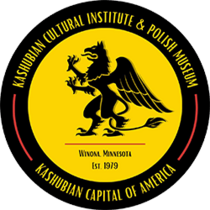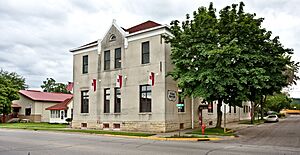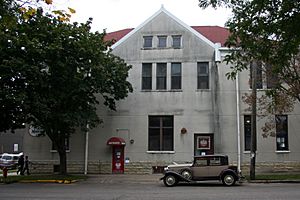- This page was last modified on 9 August 2025, at 07:22. Suggest an edit.
Kashubian Cultural Institute & Polish Museum facts for kids
 |
|

Viewed from the intersection of Liberty Street and Second Street
|
|
| Established | 1979 |
|---|---|
| Location | 102 Liberty Street, Winona, Minnesota 559873, United States |
| Type | Ethnographic history |
The Kashubian Cultural Institute & Polish Museum is a special place that helps keep the history and culture of Polish and Kashubian people alive in Winona, Minnesota. It started in 1979. People in Winona often call it the Polish Museum.
The museum is in an old building that used to be an office for a lumber company. This building was built way back in 1890. The museum's name was updated to include "Kashubian" because of Jeff Turkowski, who wanted to show more about the Kashubian culture in Winona.
Contents
How the Museum Started
In 1979, a priest from Winona named Father Paul Breza bought the old lumber office building. He wanted to use it to store historical items from Polish immigrants who came to Winona.
At first, there were two different groups working on Polish heritage in Winona. But Father Breza helped create the Polish Cultural Institute in 1979. This group worked to fix up the museum and help people learn about the important things Polish people brought to the Winona community.
Winona is even known as the "Kashubian Capital of America." The museum helps celebrate this. Winona also has a special "Sister City" program with Bytów, a town in Poland. This helps connect the two places.
Later, in 2010, Father Breza was honored by one of the other Polish heritage groups. This helped bring the groups together. Another important person connected to the museum was Anne Pellowski. She was a writer and teacher who lived in Winona for many years.
Exploring the Museum
The first floor of the museum has many exhibits. These exhibits show what life was like for Polish and Kashubian immigrants in Winona. You can also find a gift shop there. The shop sells books, clothes, music, and other items, many of which come from Poland.
The museum has also bought two other buildings nearby. One is the Schultz House, which is being fixed up to show what a historic home looked like. The other is the Morrison Annex Event Center. This center is used for cultural events like dances and music shows. The Morrison Annex also has a very long mural, which is a painting on a wall. This mural shows the lives and contributions of Polish and Kashubian families in Winona.
Church History Collection
The second floor of the museum has a collection of items from churches in the Winona area. These items include things from the Basilica of Saint Stanislaus Kostka. Father Breza collected and cared for these items.
This collection is very large. It includes statues, church furniture, special clothes worn by priests, and other old items from Polish Catholic churches in the United States from the 1800s. Sometimes, parts of this collection are lent to other Catholic churches. This helps those churches feel more connected to their history.
Fun Cultural Activities
The Kashubian Cultural Institute & Polish Museum works hard to help people understand Polish and Kashubian culture. This includes the culture of immigrants in Winona and modern Poland.
In recent years, more people have become interested in Kashubian-American culture. The museum now features Kashubian customs. These include events like the Blessing of Flowers and "Smaczne Jablka," which means "Tasty Apples" or Apple Fest. The museum also connects with Kashubian Poles, especially in Bytów, Poland, which is Winona's sister city.
One regular activity is an exchange program where high school students from Bytów visit Winona, and Winona students visit Bytów. Another fun activity is musical performances at the Morrison Annex. These can be local polka bands or even newly discovered music written by Polish immigrants.

